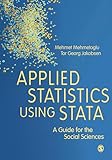Applied statistics using stata / Mehmet Mehmetoglu, Tor Georg Jakobsen.
Material type: TextLanguage: English Description: pages cmISBN:
TextLanguage: English Description: pages cmISBN: - 9781473913226
- 9781473913233 (pbk)
- 9781473913226 (hb)
- 519.502 MEH
| Item type | Current library | Collection | Call number | Status | Date due | Barcode |
|---|---|---|---|---|---|---|
 General Books
General Books
|
CUTN Central Library Sciences | Non-fiction | 519.502 MEH (Browse shelf(Opens below)) | Available | 32548 |
Browsing CUTN Central Library shelves, Shelving location: Sciences, Collection: Non-fiction Close shelf browser (Hides shelf browser)

|

|

|

|

|

|

|
||
| 519.502 LIN Basic statistics for business and economics. | 519.502 LIN Basic statistics for business and economics. | 519.502 LIN Basic statistics for business and economics. | 519.502 MEH Applied statistics using stata / | 519.502 PEE Statistical analysis for education and psychology researchers / | 519.502 PEE Statistical analysis for education and psychology researchers / | 519.502 TIM Data science : a first introduction / |
Clear, intuitive and written with the social science student in mind, this book represents the ideal combination of statistical theory and practice. It focuses on questions that can be answered using statistics and addresses common themes and problems in a straightforward, easy-to-follow manner. The book carefully combines the conceptual aspects of statistics with detailed technical advice providing both the `why' of statistics and the `how'.
Built upon a variety of engaging examples from across the social sciences it provides a rich collection of statistical methods and models. Students are encouraged to see the impact of theory whilst simultaneously learning how to manipulate software to meet their needs.
The book also provides:
Original case studies and data sets
Practical guidance on how to run and test models in Stata
Downloadable Stata programmes created to work alongside chapters
A wide range of detailed applications using Stata
Step-by-step notes on writing the relevant code.
This excellent text will give anyone doing statistical research in the social sciences the theoretical, technical and applied knowledge needed to succeed.
Research and statistics
1.1 The methodology of statistical research
1.2 The statistical method
1.3 The logic behind statistical inference
1.4 General laws and theories
1.5 Quantitative research papers
2. Introduction to Stata
2.1 What is Stata?
2.2 Entering and importing data into Stata
2.3 Data management
2.4 Descriptive statistics and graphs
2.5 Bivariate inferential statistics
3. Simple (bivariate) regression
3.1 What is regression analysis?
3.2 Simple linear regression analysis
3.3 Example in Stata
4. Multiple regression
4.1 Multiple linear regression analysis
4.2 Example in Stata
5. Dummy-Variable Regression
5.1 Why dummy-variable regression?
5.2 Regression with one dummy variable
5.3 Regression with one dummy variable and a covariate
5.4 Regression with more than one dummy variable
5.5 Regression with more than one dummy variable and a covariate
5.6 Regression with two separate sets of dummy variables
6. Interaction/moderation effects using regression
6.1 Interaction/moderation effect
6.2 Product-term approach
7. Linear regression assumptions and diagnostics
7.1 Correct specification of the model
7.2 Assumptions about residuals
7.3 Influential observations
8. Logistic regression
8.1 What is logistic regression?
8.2 Assumptions of logistic regression
8.3 Conditional effects
8.4 Diagnostics
8.5 Multinomial logistic regression
8.6 Ordered logistic regression
9. Multilevel analysis
9.1 Multilevel data
9.2 Empty or intercept-only model
9.3 Variance partition / intraclass correlation
9.4 Random intercept model
9.5 Level-2 explanatory variables
9.6 Logistic multilevel model
9.7 Random coefficient (slope) model
9.8 Interaction effects
9.9 Three-level models
10. Panel data analysis
10.1 Panel data
10.2 Pooled OLS
10.3 Between effects
10.4 Fixed effects (within estimator)
10.5 Random effects
10.6 Time-series cross-section methods
10.7 Binary dependent variables
11. Exploratory factor analysis
11.1 What is factor analysis?
11.2 Factor analysis process
11.3 Composite scores and reliability test
11.4 Example in Stata
12. Structural equation modelling and confirmatory factor analysis
12.1 What is structural equation modelling?
12.2 Confirmatory factor analysis
12.3 Latent path analysis
13. Critical issues
13.1 Transformation of variables
13.2 Weighting cases
13.3 Robust regression
13.4 Missing data


There are no comments on this title.